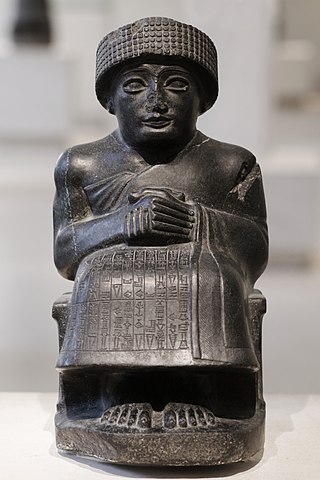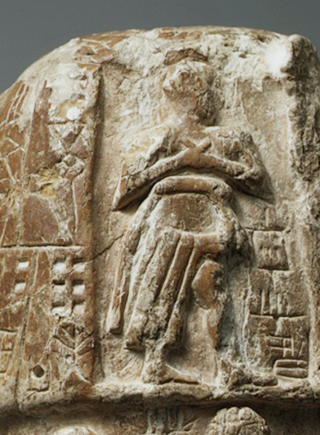Notes
- ↑ Thorkild Jacobsen, The Sumerian King List (Chicago: University of Chicago Press, 1939), pp. 112-115
| Imi 𒄿𒈪 | |
|---|---|
| King of Akkad | |
| Reign | c. 2192 – c. 2191 BC |
| Predecessor | Possibly Igigi |
| Successor | Possibly Nanum |
| Died | c. 2191 BC |
Imi (died c. 2191 BC), according to the Sumerian King List , was one of four rivals (the others being Igigi, Ilulu, and Nanum) vying to be king of the Akkadian Empire during a three-year period following the death of Shar-kali-sharri. [1] This chaotic period came to an end when Dudu consolidated his power over the realm.

Sumer is the earliest known civilization, located in the historical region of southern Mesopotamia, emerging during the Chalcolithic and early Bronze Ages between the sixth and fifth millennium BC. Like nearby Elam, it is one of the cradles of civilization, along with Egypt, the Indus Valley, the Erligang culture of the Yellow River valley, Caral-Supe, and Mesoamerica. Living along the valleys of the Tigris and Euphrates rivers, Sumerian farmers grew an abundance of grain and other crops, a surplus which enabled them to form urban settlements. The world's earliest known texts come from the Sumerian cities of Uruk and Jemdet Nasr, and date to between c. 3350 – c. 2500 BC, following a period of proto-writing c. 4000 – c. 2500 BC.

The Sumerian King List or Chronicle of the One Monarchy is an ancient literary composition written in Sumerian that was likely created and redacted to legitimize the claims to power of various city-states and kingdoms in southern Mesopotamia during the late third and early second millennium BC. It does so by repetitively listing Sumerian cities, the kings that ruled there, and the lengths of their reigns. Especially in the early part of the list, these reigns often span thousands of years. In the oldest known version, dated to the Ur III period but probably based on Akkadian source material, the SKL reflected a more linear transition of power from Kish, the first city to receive kingship, to Akkad. In later versions from the Old Babylonian period, the list consisted of a large number of cities between which kingship was transferred, reflecting a more cyclical view of how kingship came to a city, only to be inevitably replaced by the next. In its best-known and best-preserved version, as recorded on the Weld-Blundell Prism, the SKL begins with a number of fictional antediluvian kings, who ruled before a flood swept over the land, after which kingship went to Kish. It ends with a dynasty from Isin, which is well-known from other contemporary sources.

The history of Sumer spans through the 5th to 3rd millennia BCE in southern Mesopotamia, and is taken to include the prehistoric Ubaid and Uruk periods. Sumer was the region's earliest known civilization and ended with the downfall of the Third Dynasty of Ur around 2004 BCE. It was followed by a transitional period of Amorite states before the rise of Babylonia in the 18th century BCE.
Uruk, the archeological site known today as Warka, was an ancient city in the Near East, located east of the current bed of the Euphrates River, on an ancient, now-dried channel of the river. The site lies 93 kilometers northwest of ancient Ur, 108 kilometers southeast of ancient Nippur, and 24 kilometers southeast of ancient Larsa. It is 30 km (19 mi) east of modern Samawah, Al-Muthannā, Iraq.
Nanum or Nanium, according to the Sumerian King List, was one of four rivals vying to be king of the Akkadian Empire during a three-year period following the death of Shar-kali-sharri. This chaotic period came to an end when Dudu consolidated his power over the realm.

Enmebaragesi (Sumerian: 𒂗𒈨𒁈𒄄𒋛Enmebárgisi [EN-ME-BARA2-GI4-SE]; fl. c. 2750 BC) originally Mebarasi (𒈨𒁈𒋛) was the penultimate king of the first dynasty of Kish and is recorded as having reigned 900 years in the Sumerian King List. Like his son and successor Aga, he reigned during a period when Kish had hegemony over Sumer.a Enmebaragesi signals a momentous documentary leap from mytho-history to history, since he is the earliest ruler on the king list whose name is attested directly from archaeology.

Ensi was a Sumerian title designating the ruler or prince of a city-state. Originally it may have designated an independent ruler, but in later periods the title presupposed subordinance to a lugal.

The Awan dynasty was the first dynasty of Elam of which very little of anything is known today—appearing at the dawn of recorded history. The dynasty corresponds to the early part of the first Paleo-Elamite period ; additionally, succeeded by the Shimashki and Sukkalmah dynasties. The Elamites were likely major rivals of neighboring Sumer from remotest antiquity—they were said to have been defeated by Enmebaragesi of Kish c. 2750 BC—who is the earliest archaeologically attested king named on the Sumerian King List (SKL); moreover, by a later monarch, Eannatum of Lagash c. 2450 BC. Awan was a city-state or possibly a region of Elam whose precise location is not certain; but, it has been variously conjectured to have been within the: Ilam and/or Fars provinces of what is today known as the Islamic Republic of Iran, to the north of Susa, close to Dezful, or Godin Tepe.
Akshak was a city of ancient Sumer, situated on the northern boundary of Akkad, sometimes identified with Babylonian Upi. It is known, based on an inscription "‘Ur-kisala, the sangu-priest of Sin of Akshak, son of Na-ti, pasisu-priest of Sin to Salam presented [this statue]." that there was a temple of the god Sin in Akshak.
Ilulu or Elulu, according to the Sumerian King List, was one of four rivals vying to be king of the Akkadian Empire during a three-year period following the death of Shar-Kali-Sharri. This chaotic period came to an end when Dudu consolidated his power over the realm.

Aga commonly known as Aga of Kish, was the twenty-third and last king in the first dynasty of Kish during the Early Dynastic I period. He is listed in the Sumerian King List and many sources as the son of Enmebaragesi. The Kishite king ruled the city at its peak, probably reaching beyond the territory of Kish, including Umma and Zabala.
En-tarah-ana of Kish was the fourth Sumerian king in the First Dynasty of Kish, according to the Sumerian king list. The Weld-Blundell Prism was damaged at this point, so Thorkild Jacobsen had restored this ruler's name as Bahina. En-tarah-ana is unlikely to have existed as his name does not appear on texts dating from the period in which he was presumed to have lived. He is awarded a reign of 420 years, 3 months, and 3 and a half days. Why the length of his reign is so specific compared to the recorded lengths of the other kings of the Early Dynastic is unknown.
Kalibum of Kish was the seventh Sumerian king in the First Dynasty of Kish, according to the Sumerian king list. This name is written "Ga-lí-bu-um ... normalized as Kalibum", and is believed to be derived from the Akkadian for 'hound'. Kalibum is unlikely to have existed as his name does not appear on texts dating from the period in which he was presumed to have lived.
Kalumum of Kish was the eighth Sumerian king in the First Dynasty of Kish, according to the Sumerian king list. Like the other members of the First dynasty prior to Etana, he was named for an animal; his name "Kalumun" is Akkadian for "lamb". Kalulum is unlikely to have existed as his name does not appear on texts dating from the period in which he was presumed to have lived.
Zuqaqip of Kish was the ninth Sumerian king of the semi-legendary First Dynasty of Kish, according to the Sumerian King List, where his length of reign is given as 900 years. His name means "Scorpion". Zuqaqip is unlikely to have existed as his name does not appear on texts dating from the period in which he was presumed to have lived.
Mashda of Kish was the eleventh Sumerian king in the First Dynasty of Kish, according to the Sumerian king list. He was a son of the king Atab. Like the other members of the First dynasty prior to Etana, he was named for an animal; his name "Mashda" is Akkadian for "gazelle". Mashda is unlikely to have existed as his name does not appear on texts dating from the period in which he was presumed to have lived.
Arwium of Kish was the twelfth Sumerian king in the First Dynasty of Kish, according to the Sumerian king list. His father was Mashda, the previous ruler. Like the other members of the First dynasty prior to Etana, he was named for an animal; his name "Arwium" is Akkadian for "male gazelle". Arwium is unlikely to have existed as his name does not appear on texts dating from the period in which he was presumed to have lived.
Ur-Nungal was the sixth Sumerian ruler in the First Dynasty of Uruk, according to the Sumerian King List, which also claims he ruled 30 years. Both the Sumerian King List and the Tummal Chronicle state he was the son of Gilgamesh, but only the Sumerian King List records he was the father of Udul-kalama.
Igigi, according to the Sumerian King List, was one of four rivals vying to be king of the Akkadian Empire during a three-year period following the death of Shar-kali-sharri. This chaotic period came to an end when Dudu consolidated his power over the realm.